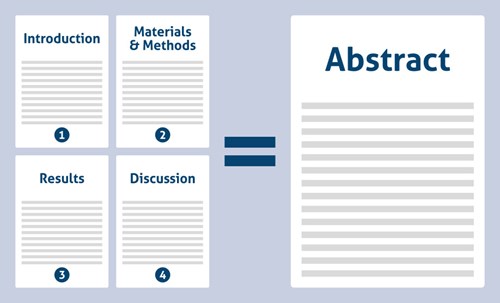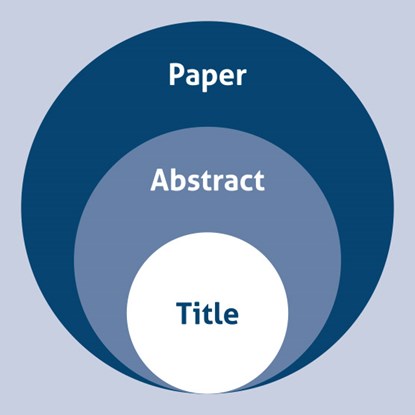How to Write a Good Scientific Abstract
An abstract is a written statement describing key facts about your research project.
Mastering the art of abstract writing is essential for boosting the visibility of your research within a given field and for ensuring its future for your career. Throughout your academic career, you will write many abstracts, covering many different projects and aimed at a wide range of audiences. Practice does make perfect in this case, treat each abstract you write as a stepping stone towards becoming an expert. Never overlook the importance of an abstract either! Often journal editors or conference organisers have to read through hundreds of abstracts, so it is vitally important that your abstract contains all the important and necessary details in a clear and concise way in order for your research to stand out. This blogs aims to show you how to write an abstract for a research paper or a conference.
Why is the abstract important?
- Helps to conduct your research
- Helps to present complex information in a clear and concise manner
- Helps to condense detailed report information into a shorter format for database searches
- Helps to provide a summary of your work for future publications and grant applications
An abstract should be:
- Informative (a brief overview of your research)
- Descriptive (including the research aim, objectives of your project, and the analytical methodologies applied)
- Critical (the key outcomes and limitations of your work should be described)
- Written in a formal language
- A conference abstract should contain 150–1000 words (limiting yourself to the word count indicated by the conference organizers)
Writing the Abstract: Step-by-Step Process
When writing an abstract, we must be sure to convey the right amount of information without going into long-winded explanations. The order of your abstract is important, so choose an order that helps the reader link each aspect of your work in a logical order (Figure 1). Always remember to ask yourself if the data presented produces any unanswered questions.
 |
Figure 1. Formatting Your Abstract
What does an abstract include?
1. Introduction: “What is the subject?” Write 1–2 introductory sentences that explain the topic, purpose, and research question(s). The background is needed, but it should not be more in-depth than the results.
2. Materials and methods: “How did you conduct the research and generate results?” Write 1–2 sentences describing your research methods (this may also include the type of data analysis you are using).
3. Results: “Why is it important? What are your discoveries?” Write 12 sentences describing the results/findings.
4. Discussion and further directions: “What is the take-home message of your project and its impact?” Write 1–2 sentences containing your conclusions and recommendations. Your conclusions are your study’s contribution to the field.
Final tip: In the end, it is very helpful if someone else reads your abstract. If possible, ask your colleagues to provide their feedback.
Please keep in mind – an abstract is important not only for the conference selection process; it is also essential for your future publication record. A good title and abstract will lead to more people reading the paper itself (Figure 2).
 |
Figure 2. A good abstract will lead to more people being involved in your research.
Top tips for writing a strong abstract
-
Follow the conference abstract guidelines. Before starting to write an abstract, check the conference’s individual guidelines, which will indicate the subsections to include or the word count that is allowed. Many guidelines may seem overly particular, but do not ignore even the most tedious requirements (e.g., font size, spacing, units of measurement, etc.) as your work is judged on all of them.
-
Stick to a standard or required structure. If the conference guidelines do not indicate a required abstract structure, stick to a conventional format (Figure 1. Step-by-step Process).
-
Do not include references unless the guidelines require them. This will help you remain within the word limit and make your abstract visually simpler to read.
-
Tailor the abstract to the right audience. You should always think about your audience while writing your abstract: who will read your abstract? What is the intended audience’s level of expertise in your subject? How familiar is your audience with any subject-specific jargon or acronyms that may appear in your abstract? For example, if the conference is focused on policy issues and you submit an abstract that highlights a clinical issue without relating it to policy, your project may not be selected for inclusion.
-
Communicate professionally and use formal language. Avoid confusion by using complete sentences, proper punctuation, and be selective regarding the main content.
-
Keep it punchy. Long sentences will lose the reader’s focus.
-
Create curiosity and avoid banality. State the conclusion concisely but avoid overstatements.
-
Say it in the title. Do not leave the audience guessing what your abstract is about. A simple and powerful title will make a good impression and encourage your audience to read the rest of your poster or choose the session that includes your oral presentation. The title is the first sentence that everyone will read. Do not make it too long or else it may bore or confuse the reader!
-
Tell them why your research is important. Describe the wider impact of your work. Why is the research being conducted in the first place?
-
The take-home message. This is the most crucial part of your abstract as it may be the only thing people will remember about your entire project.
Written by Dr. Karolina Szczesna
Senior Product Manager and Technical Support at Proteintech Ltd.


